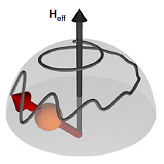Unsuspected movements inside magnetic materials

 Figure extracted from the publication: (a) Relaxation of the precession motion of a magnetic dipole (i.e. a magnet), (b) nutation motion superimposed on the precession.
Figure extracted from the publication: (a) Relaxation of the precession motion of a magnetic dipole (i.e. a magnet), (b) nutation motion superimposed on the precession.
An incomplete model
When a magnetic field is applied to a magnetic dipole (a compass for example), the axis of the dipole starts to rotate rapidly around the magnetic field. This motion is called the Larmor precession movement. With a magnetic field of 1 Tesla, this movement reaches a frequency of about 20 GHz, or 20 billion revolutions per second.
In theory, if the magnetic field is cut, the precession stops instantly. Indeed, the description of precession kinetics does not include inertia. However, an accelerated (or decelerated) dipole radiates and loses energy, so it cannot stop instantaneously.
This observation shows that the description of magnetization dynamics seems incomplete. But until recently, this problem was not studied because on the one hand, there was not interest for applications, and on the other hand, the measurement technologies did not allow to probe speeds much higher than that of precession (i.e. in the THz domain) which were nevertheless necessary for its understanding.
Towards the discovery of an additional motion
The situation has changed in recent years, in particular through increased technological demand for higher read and write speeds in magnetic information storage devices (Magnetic Random-Access Memory, or Magnetic Logic Devices) such as computer hard disk drives.
About ten years ago, a team from the Laboratoire des solides irradiés* under the direction of Jean-Eric Wegrowe, professor at the École Polytechnique, developed a model predicting the effect of inertia due to magnetization precession: inertia manifests itself by a nutation motion that is superimposed on the precession, i.e. oscillations of the axis of rotation (see figure).
Observations to confirm the phenomenon
This model was first developed as part of a thesis (Monge Scholarship from the École Polytechnique) and was the origin of a ten-year quest to result in its experimental demonstration. Jean-Eric Wegrowe succeeded in building an international team of experts, with the possibility of working on a large power instrument, the "Free electron Laser" at the Helmoltz centrum in Dresden, Germany. These efforts have resulted in a first experimental demonstration of nutation resonance, published this week in the journal Nature Physics.
This discovery is only the beginning of the understanding of this phenomenon, which will require additional measurements with more powerful instruments, but it opens the way to the development of original technologies for ultra-fast information processing devices.
> More information: read the publication
*LSI : Irradiated Solids Laboratory, a joint research unit CNRS - École Polytechnique - CEA
 Support l'X
Support l'X